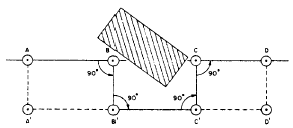|
Bypassing an Object by
Perpendicular
Offset This method is used when a large obstruction,
such
as a building, is in the line of sight between two
points. The solution establishes a line parallel to
the original line at a distance clear from the obstacle,
as shown in figure 13-18. The instrument

Figure 13-18.-Bypassing a large obstacle
by
the perpendicular offset method.
is set up at B, and a 90 angle is turned from line
AB.
The distance BB is carefully measured and recorded.
The instrument is moved to B, and another
90 angle is turned. BC is laid off to clear
the obstacle. The instrument is moved to C, and
a third 90 angle is turned. Distance CC, equal
to BB, is measured and marked. This establishes
a point C on the original line. The instrument
is moved to C, and a fourth 90 angle is
turned to establish the alignment CD that is the extension
of AB beyond the obstacle.
When the distance to clear the obstacle, BB or
CC, is less than a tape length, you can avoid turning
four 90 angles as follows: Erect perpendicular offsets
from points A and B in figure 13-18 so
that AA equals BB. Set up the instrument at B,
and measure angle ABB to be sure that its 90.
Extend line AB to C and then to D, making
sure that point C clears the obstacle. Then,
lay off perpendicular offset CC equal to AA
or BB and perpendicular offset DD equal to
CC. Then, line CD is the extension of line AB. The
total distance of the line AD is the sum of the
distances AB, BC, and CD.
You also compute the diagonals formed by the end
rectangles and compare the result to the actual
measurement, if you can, as a further check.
|


|







